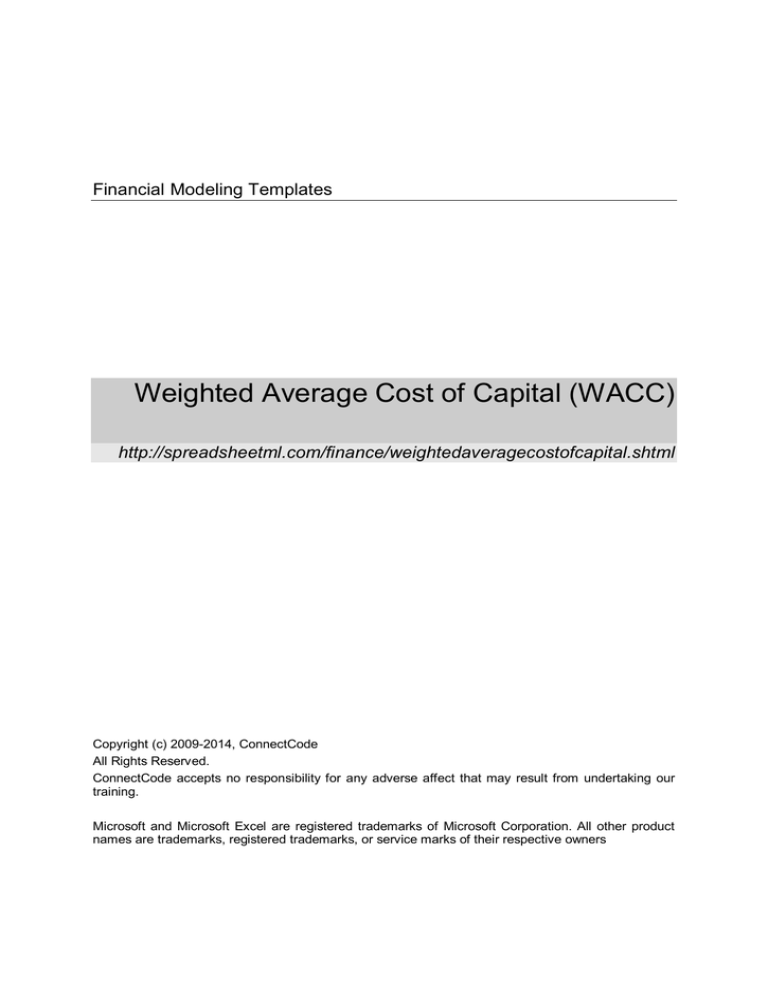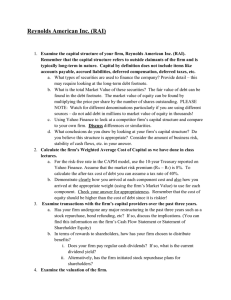
Financial Modeling Templates
Weighted Average Cost of Capital (WACC)
http://spreadsheetml.com/finance/weightedaveragecostofcapital.shtml
Copyright (c) 2009-2014, ConnectCode
All Rights Reserved.
ConnectCode accepts no responsibility for any adverse affect that may result from undertaking our
training.
Microsoft and Microsoft Excel are registered trademarks of Microsoft Corporation. All other product
names are trademarks, registered trademarks, or service marks of their respective owners
Table of Contents
1.
Cost of Capital.................................................................................................................. 1-1
1.1
Cost of Capital ....................................................................................................... 1-1
1.2
Weighted Average Cost of Capital (WACC) ........................................................... 1-1
1.3
Cost of Equity ........................................................................................................ 1-2
1.3.1 Cost of Equity (Gordon)............................................................................. 1-2
1.3.2 Cost of Equity (Capital Asset Pricing Model) .............................................. 1-3
1.4
Cost of Debt .......................................................................................................... 1-4
Pg ii
Weighted Average Cost of Capital
Version 1.0
ConnectCode’s Financial Modeling Templates
Have you thought about how many times you use or reuse your financial models? Everyday, day
after day, model after model and project after project. We definitely have. That is why we build all
our financial templates to be reusable, customizable and easy to understand. We also test our
templates with different scenarios vigorously, so that you know you can be assured of their
accuracy and quality and that you can save significant amount of time by reusing them. We have
also provided comprehensive documentation on the templates so that you do not need to guess or
figure out how we implemented the models.
All our template models are only in black and white color. We believe this is how a professional
financial template should look like and also that this is the easiest way for you to understand and
use the templates. All the input fields are marked with the ‘*’ symbol for you to identify them
easily.
Whether you are a financial analyst, investment banker or accounting personnel. Or whether you
are a student aspiring to join the finance world or an entrepreneur needing to understand finance,
we hope that you will find this package useful as we have spent our best effort and a lot of time in
developing them.
ConnectCode
Pg iii
Weighted Average Cost of Capital
Version 1.0
1.
1.1
Cost of Capital
Cost of Capital
Capital is the money that a company uses to finance its business. For example, in buying assets
for operating the business and investing in projects that generate cash flows for the company. The
capital can come from investors who invest in the common stocks of the company or from funds
borrowed from others known as debt. The cost of capital can be thought of as the cost of doing
business.
Imagine if the company uses only common stocks (equity) to finance all its assets, then the
stockholders will own all the assets and all the cash flows generated by the business. The investors
will be expecting a certain rate of return for putting money into the common stock. The cost of
capital in this case can be thought of as the required rate of return by the investors. When the
company needs to invest in a new project, it may need to consider whether the returns will be able
to meet the expectations of the investors.
To complicate matters, most companies use a mixture of debt and equity to finance their business.
Thus cost of capital involves a mixture of the cost of equity and the cost of debt. In this case, the
cost of capital for a company is the required rate of return that the company needs to earn in
order to pay the debts and to meet the expectations of the rate of return required by the
investors.
1.2
Weighted Average Cost of Capital (WACC)
Weighted Average Cost of Capital is defined as the average cost of capital for a company,
calculated as a weighted average of the costs of equity and the costs of debt.
The formula below is used to calculate the Weighted Average Cost of Capital (WACC):
WACC = (Debt / (Debt + Equity)) * Cost of Debt + (Equity / (Debt + Equity)) * Cost of Equity
Equity = Shares Market Price * Shares Issued
Cost of Debt is usually defined as the after-tax cost of debt:
After-tax Cost of Debt = (1- Tax Rate)* Cost of Debt
The WACC Calculator spreadsheet uses the formula above to calculate the Weighted Average Cost
of Capital.
Pg 1-1
Weighted Average Cost of Capital
Version 1.0
1.3
Cost of Equity
The Cost of Equity is defined as the rate of return that an investor expects to earn for bearing risks
in investing in the shares of a company. Two common ways of calculating the Cost of Equity is the
Dividend Growth Model by Gordon and the Capital Asset Pricing Model (CAPM).
1.3.1
Cost of Equity (Gordon)
In the Dividend Growth Model by Gordon, the price of a company stock is calculated as the sum of
all the company's future dividends. The dividends are assumed to be growing at a constant rate.
Price of Stock Today = (Current Dividend * (1+ Dividend Growth Rate)) / (Required ReturnDividend Growth Rate)
Rearranging the formula gives us the following:
Required Return = (Current Dividend * (1+ Dividend Growth Rate))/Current Price of Stock +
Dividend Growth Rate
The Required Return is the Cost of Equity and this is calculated in the worksheet CostofEquityGordon.
In the CostofEquity-Gordon-DivHistory worksheet, ths Cost of Equity is calculated using the same
formula as mentioned above. The Growth Rate is however estimated from the Dividend History.
Pg 1-2
Weighted Average Cost of Capital
Version 1.0
1.3.2
Cost of Equity (Capital Asset Pricing Model)
The Capital Asset Pricing Model is a theory that describes the relationship of the expected rate of
return as a function of the risk free interest rate, the investment's beta, and the expected market
risk premium.
Expected rate of return = Risk free rate + Beta * (Market Risk Premium)
The Expected rate of return is the Cost of Equity and this is calculated in the worksheet Cost of
Equity (CAPM).
Pg 1-3
Weighted Average Cost of Capital
Version 1.0
1.4
Cost of Debt
A company's debt is usually a mixture of loans, bonds and other securities. A company's Cost of
Debt is the interest rate that a company pays on its debt. It is important to note that the interest a
company pays is a tax deductible expense. Thus the after-tax rate is usually used for a company's
cost of debt.
After-tax Cost of Debt = (1 - Tax Rate) * Cost of Debt
Pg 1-4
Weighted Average Cost of Capital
Version 1.0






